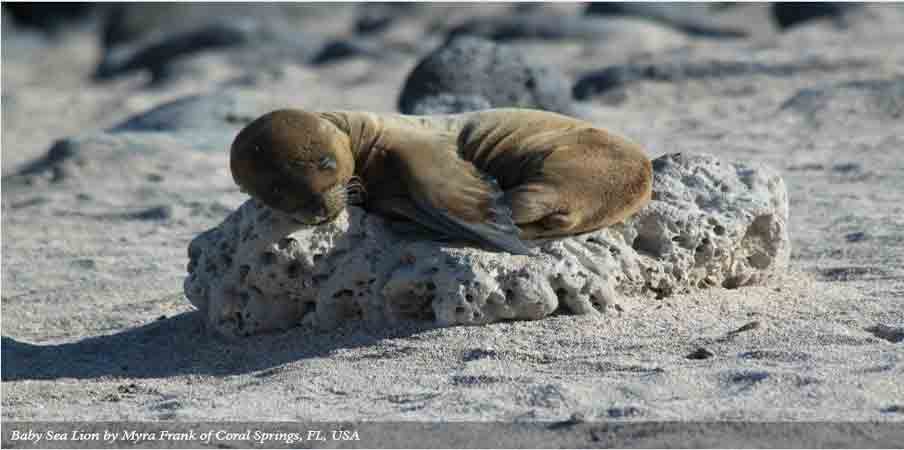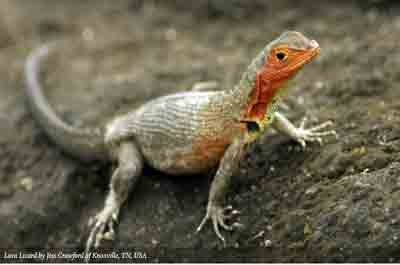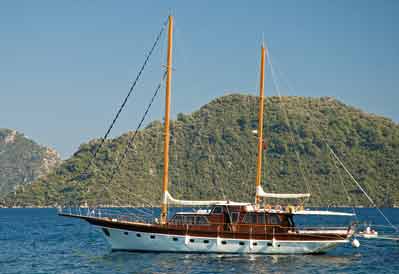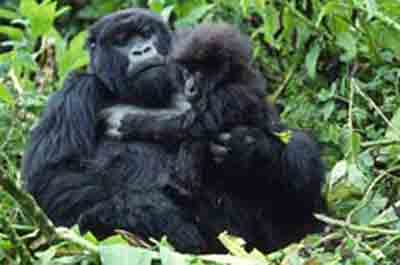Galapagos Islands - A Visitors Guide

The Galapagos Islands are a model for eco-tourism and one of the most unique, scientifically important, and biologically outstanding areas on earth.
This is not the Caribbean or the South Pacific with their mega resorts, palm trees, and white sandy beaches. Most of what you will see are islands that are devoid of vegetation ---- looking more like the moon than a tropical paradise.
You don't have to be an evolutionary biologist or an ornithologist to appreciate the significance of the Galapagos Islands and it being a biological laboratory used to help formulate the theory of evolution.
Many travelers describe their time on the islands as a life-changing experience. The endemic fauna includes invertebrate, reptile and bird species. There are a few indigenous mammals. All the reptiles, except for two marine tortoises, are endemic.
The Galapagos Islands still remain one of the few places left on earth where the footprint of the human presence is kept to a minimum.
The 19 islands that make up the archipelago are situated in the Pacific Ocean 600 miles (1000 km) from the South American continent, and are uniquely located at the confluence of five ocean currents.
The periodic seismic and volcanic activity, the confluence of ocean currents, and the extreme isolation of the islands, has created an environment for the development of unusual animal life. These include the land iguana, the giant tortoise and the many types of finch that led to the inspiration and natural biological laboratory for Charles Darwin's "theory of evolution" following his visit in 1835.
What the Galapagos Islands Meant to Charles Darwin
Charles Darwin presents a view that if individuals vary with respect to a particular trait and if these variants have a different likelihood of surviving to the next generation, then in the future, there will be more of those with the variant more likely to survive. On the Origin of Species, Charles Darwin offered a compelling answer to the outstanding question of biology, which was "how life on earth had evolved."
In 1835, on on his journey to the Galapagos Islands archipelago. Darwin collected geological and biological specimens on the islands.
His key observations of different species of birds, reptiles (tortoises, iguanas, etc.), and plants, and other species from the inter-island variations led to his later conclusions on the theory of evolution.
In 1859 Darwin published the Origin of Species which changed the way we look at and understand the world. The book focused on the transmutations of species and explained, in detail the mechanism that underlies evolutionary change. Darwin discounted the predominant view of the time by presenting observations on the high number of endemic species found in the islands, the close interrelatedness of these species, and the absence of some groups of species. All of these observations ran contrary to the reasoning behind "Special Creation," then the dominant explanation of the distribution of species.
The Most Visited Islands
Baltra (South Seymour) Island - A small flat island located near the centre of the Galápagos. The island is arid and vegetation consists of salt bushes, prickly pear cacti and palo santo trees. Private planes flying to Galápagos must fly to Baltra as it is the only airport with overnight facilities. On arriving in Baltra, all visitors are immediately transported by bus to one of two docks. The first dock is located in a small bay, where the boats cruising Galápagos await passengers. The second is a ferry dock, which connects Baltra to the island of Santa Cruz.
Bartolomé (Bartholomew) Island - Located just off the east coast of Santiago Island. This island is one of the few that is home to the Galapagos penguin which is the only wild penguin species to live on the equator. The green turtle is another animal that resides on the island.
Darwin (Culpepper) Island - The island is inhabited by fur seals, frigates, marine iguanas, swallow-tailed gulls, sea lions, whales, marine turtles, and red-footed and Nazca boobies.
Española (Hood) Island - The southernmost island in the group. Due to its remote location, it has a large number of endemic species. It has its own species of lava lizard, mockingbird, and tortoise. Española's marine iguanas exhibit a distinctive red coloration change between the breeding season. Española is the only place where the waved albatross nests. Española's steep cliffs serve as the perfect runways for these birds, which take off for their ocean feeding grounds near the mainland of Ecuador and Peru. There are two spots on the island attractive to visitors: Española. Gardner Bay is a swimming and snorkeling site, and offers a great beach. Punta Suarez has migrant, resident, and endemic wildlife, including brightly colored marine iguanas, Española lava lizards, hood mockingbirds, swallow-tailed gulls, blue-footed boobies, Nazca boobies, red-billed tropic birds,Galápagos hawks, 3 species of Darwin's finches, and the waved albatross.
Fernandina (Narborough) Island - Here you can find hundreds of marine iguanas on black lava rocks. The famous flightless cormorants inhabit this island, as do Galápagos penguins, pelicans, Galápagos sea lions and Galápagos fur seals. Different types of lava flows can be compared, and the mangrove forests can be observed.
Floreana (Charles or Santa María) Island - Flamingos and green sea turtles nest (December to May) on this island. The patapegada or Galápagos petrel, a sea bird which spends most of its life away from land, is found here. At the "Devil's Crown", an underwater volcanic cone and coral formations are found.
Genovesa (Tower) Island - At Darwin Bay, frigate birds and swallow-tailed gulls, the only nocturnal species of gull in the world, can be seen. Red-footed boobies, noddy terns, lava gulls, tropic birds, doves, storm petrels and Darwin finches are also in sight.
Isabela (Albemarle) Island - Here you can find Galápagos penguins, flightless cormorants, marine iguanas, pelicans and many Sally Light foot crabs. The third-largest human settlement of the archipelago, Puerto Villamil, is located at the southeastern tip of the island. It is the only island to have the equator run across it. It is also the only place in the world where a penguin can be in its natural habitat in the Northern Hemisphere.
Marchena (Bindloe) Island - Here you can find Galápagos hawks and sea the Marchena lava lizard, an endemic animal.
North Seymour Island - Here you can find a large population of blue-footed boobies and swallow-tailed gulls. It hosts one of the largest populations of frigate birds.
Rábida (Jervis) Island - This island is known for its red color due to the high amount of iron contained in the lava. White-cheeked pintail ducks live in a saltwater lagoon close to the beach, where brown pelicans and boobies have built their nests.
San Cristóbal (Chatham) Island - This island is home to frigate birds, sea lions, giant tortoises, blue- and red-footed boobies, tropic birds, marine iguanas, dolphins and swallow-tailed gulls. The island has the largest freshwater lake in the archipelago, Laguna El Junco.
Santa Cruz (Indefatigable) Island - This island is home to the largest human population in the archipelago. Charles Darwin Research Station and the headquarters of the Galápagos National Park Service are located here. This is where they operate a tortoise breeding center where young tortoises are hatched, reared, and prepared to be reintroduced to their natural habitat. Large tortoise populations are found here as well as the last remaining Pinta tortoise, called Lonesome George. Scientists were attempting to breed him, however, Lonesome George died in June 2012 without producing any offspring.
Santa Fé (Barrington) Island - Here you will find a forest of Opuntia cactus, which are the largest of the archipelago, and Palo Santo. Weathered cliffs provide a haven for swallow-tailed gulls, red-billed tropic birds and shear-waters petrels. Santa Fe species of land iguanas are often seen, as well as lava lizards.
Santiago (San Salvador, James) Island - Marine iguanas, sea lions, fur seals, land and sea turtles, flamingos, dolphins and sharks are found here.
Wolf (Wenman) Island - Here you can find fur seals, frigate birds, Nazca and red-footed boobies, marine iguanas, sharks, whales, dolphins and swallow-tailed.
How to Get There
Flights from the Ecuador mainland cities of Quito and Guayaquil arrive at two airports: Isla Baltra just north of Santa Cruz and Isla San Cristóbal. There are almost an equal number of flights to Baltra and San Cristóbal.
Many of the cruise tour operators offer packages which include airfare to the islands in their cruise packages.
Where To Stay on The Islands
Most of the visitors to the Galapagos Islands stay overnight on board small ship cruises anchored off the islands. There are just four Inhabited islands: Santa Cruz, Isabela, San Cristobal, and Floreana, that have land accommodations for visitors who wish to remain on the islands.
Iguana Crossing
Isabella Island
Located across the street from the beach, with access to the Mangrove trail, and close to town. Iguana Crossing offers an oceanfront swimming pool, Jacuzzi, 12 fully equipped rooms and a master suite.
Red Mangrove Aventura Lodge
Santa Cruz island
Offers a great view of view of Puerto Ayora's bay. The lodge has a unique architecture design which blends with mangrove forest and seafront. Its location is ideal to observe the mangrove ecosystem. 14 guest rooms divided in 2 areas, seaside, or inside the mangrove, all equipped with a/c, cable TV, private bathroom and hot water. Sea side restaurant with choice of Japanese or Galapagos fusion cuisine
Pimampiro Hosteria
San Cristobal island
Located 5-7 minutes by bike from downtown, this is an ideal place to stay for a family with kids. They have kitchenettes and a swimming pool.
Red Mangrove Floreana Lodge
Floreana Island
Located on the least populated of Galapagos Islands with a total of 150 inhabitants, they are situated in front of the ocean on black lava surface. They offer 10 independent rustic cabins built with pine wood from the mainland man made forests, Each cabin is equipped with 1 twin size bed and a bunk bed can host up to 3 people each.


